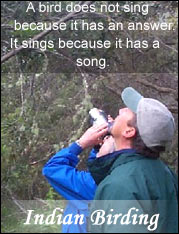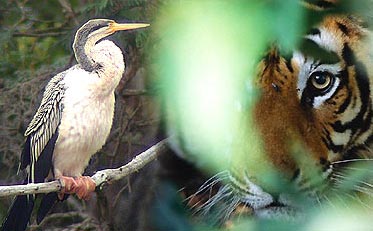 |
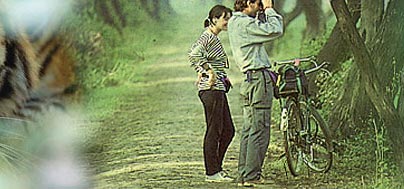 |
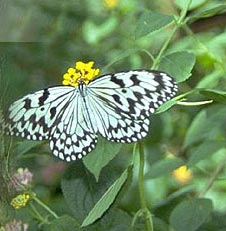 |
||
|
||||
Wildlife
Tours In India
Wildlife Tour of India and Nepal
Duration : 20 Nights / 21 Days
Destination Covered : Delhi - Jaipur - Ranthambore - Bharatpur - Agra -Khajuraho - Bandhavgarh - Kanha - Nagpur - Delhi - Varanasi - Kathmandu - Pokra - - Kathmandu - Delhi
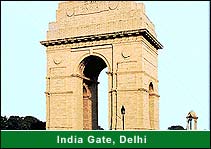 Day
1 : Delhi
Day
1 : Delhi
Company representatives will receive you on arrival at the international airport in Delhi late in the night or midnight. Transfer to your hotel. Relax.
DELHI, the capital of kingdoms and empires is now a sprawling metropolis with a fascinating blend of the past and the present. It is a perfect introduction to the composite culture of an ancient land. A window to the kaleidoscope - that is India.
Overnight will be at Delhi.
Day 2 : Delhi - Jaipur
By Road : 260 Km in 6 hr
After breakfast drive to beautiful Pink City - Jaipur.
Reach and check in at hotel.
JAIPUR - The origins of the beautiful city of Jaipur can be traced back to the eighteenth century, during the reign of Jai Singh II who ascended the Amber throne in 1699. Jaipur today, epitomizes the spirit of Rajputana. In-spite of growing into a bustling metropolis, it still retains its character and history - A beautiful fusion of the yesteryears and modernity. It is popularly known as the Pink City because of the extensive use of the locally abundant pink plastered stone, painted so in honor of the visit of the royal consort of Queen Victoria. Jaipur thrills the soul with its massive forts, magnificent palaces, exquisite temples and lush gardens.
Proceed for excursion to Amber Fort in the outskirts of Jaipur. Elephant ride ascent to the fort.
AMBER FORT PALACE - Amber is the classic romantic Rajasthani fort palace. Its construction was started by Man Singh I in 1592, and completed by his descendent Jai Singh I. Its forbidding exterior belies an inner paradise where a beautiful fusion of Mughal and Hindu styles finds its ultimate expression.
Explore the city markets. Overnight will be at Jaipur.
Day 3 : Jaipur - Ranthambhore
By Road : 156 Km in 3 hr
Proceed for sightseeing of the city after breakfast.
CITY PALACE - A delightful blend of Mughal and traditional Rajasthani architecture, the City Palace sprawls over one-seventh of the area in the walled city. It houses the Chandra Mahal, Shri Govind Dev Temple and the City Palace Museum.
JANTAR MANTAR - This is the largest and the best preserved of the five observatories built by Jai Singh II in different parts of the country. This observatory consisting of outsized astronomical instruments is still in use.
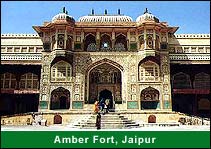 HAWA
MAHAL - The ornamental facade of this "Palace of Winds" is a prominent
landmark in Jaipur. It is a five-storey structure of sandstone plastered pink
encrusted with fine trelliswork and elaborate balconies. The palace has 953
niches and windows. Built in 1799 by Pratap Singh, the Mahal was a royal grandstand
for the palace women.
HAWA
MAHAL - The ornamental facade of this "Palace of Winds" is a prominent
landmark in Jaipur. It is a five-storey structure of sandstone plastered pink
encrusted with fine trelliswork and elaborate balconies. The palace has 953
niches and windows. Built in 1799 by Pratap Singh, the Mahal was a royal grandstand
for the palace women.
Proceed to Ranthambhore and reach by late afternoon.
Evening free at the resort and you can relax or watch some slides on the tiger.
Ranthambhore Tiger Reserve, at the junction of the Aravalis and the Vindhyas, is a unique example of natural and historical richness, standing out conspicuously in the vast, arid and denuded tract of eastern Rajasthan, barely 14 kilometers from Sawai Madhopur. Get in tune with nature for a luxury holiday in the heart of the jungle. Ranthambhore <the_town.html> - perhaps the best place in the world to sight a tiger in the wild. The Ranthambhore National Park <the_sanctuary.html> has had more Tiger sightings than any other National Park in the country. It has come to be known as "The land of the Tiger", where most of the documented footage of this majestic beast has been recorded.
It spreads over a highly undulating topography varying from gentle to steep slopes; from flat topped hills of the Vindhyas to the conical hillocks and sharp ridges of the Aravalis, from wide and flat valleys to narrow rocky gorges. An important geological feature the ‘Great Boundary Fault’ where the Vindhya plateaus meet the Aravali hill ranges, meanders through the Reserve. The National Park is bound by the rivers Chambal in the south and Banas in the north.
Ranthambhore forest is of tropical dry deciduous type, further classified as Dhok climax forest because of the predominance of Dhok (Anogeissus pendulla) found nearly everywhere. Dhok is an extremely hardy tree, capable of withstanding prolonged droughts. The leaves of this tree are good fodder and they are browsed by herbivores, and form a significant part of their diet. Even the dry, fallen leaves, eaten by them, are rich source of nutrition.
Palas or Cheela or the Flame of the Forest (Butea monosperms) blooms magnificently around mid-April. During the period, Kachida and Anatpura provide an amazing view, like a forest on fire. Around Kamaldhar massive Gum trees (Sterculia urens) with smooth white trunk stand out conspicuously. Similarly, Gurjan (Lannea coromandelica) with greyish trunks at the banks of the lakes and soft wood Salar (Boswellia serrata) dotted atop hills are noticeable.
The lakes abound with aquatic vegetation including duck weeds, lilies and lotus.
A haven for a multitude of wild animals, the Park boasts of playing host to tigers, leopards, the elusive caracals, hyenas, sloth bears, wild boars, crocodiles and so on. Besides, there are over 300 species of birds, from the majestic Crested Serpent Eagle to the exotic Golden Oriole.
Tiger, at the apex of the food chain, lord over the kingdom in a subtle way. Solitary by nature, it operates in stealth. Therefore tiger sightings, frequent as they are, are always a matter of chance. However, even evidences of tiger's activities are very exciting.
Overnight will be at resort.
Day 4 : Ranthambore
Breakfast will be at the lodge.
Proceed for full day game viewing inside the jungle. (Two safaris with lunch break in-between)
Overnight will be at the resort.
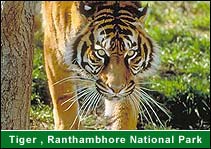 Day
5 : Ranthambore - Bharatpur
Day
5 : Ranthambore - Bharatpur
Keoladeo Ghana National Park
By Road: 200 km in 4 hr
Proceed to Bharatpur after breakfast
Just 176 km from Delhi is a very special wilderness - the Keoladeo Ghana National Park, one of the finest water-bird sanctuaries in the world. The Maharaja of Bharatpur artificially created the lake and wetland in the 19th century. By building small dykes and dams and diverting water from an irrigation canal, he converted this low-lying area into a fine wild fowl shooting preserve. In a few years, the new wetland surrounded by marginal forests was able to support thousands of water birds.
Commonly referred to as Bharatpur, the Park is a delight for bird watchers. Over 375 species of birds are found here and raised paths, camouflaged by babul trees and undergrowth make viewing easy. A quiet ride by boat in the early hours of the morning is also unforgettable experience. The cacophony is unbelievable as painted storks, open bills, spoonbills, egrets, cormorants, white ibis and multitudes of others, tend their young. Jacanas with their iridescent colors and elegant tail feathers and purple moorhen can be seen delicately treading over the floating vegetation.
Every year Bharatpur waits with bated breath for the arrival of the Siberian cranes. There are only two wintering places for this rare species one in Iran and the other Bharatpur and these beautiful birds with their distinctive red beaks and facial patches, fly over 6400 km from their summer retreats.
Colorful kingfishers, graceful pelicans rare Siberian cranes and Trans- continental fliers - the migratory water - fowl are amongst the 375 species of birds found in the Keoladeo National Park. The most spectacular nesting is that of the egrets, storks, herons and cormorants, which make over 10,000 nests every year. This makes outstanding bird havens of the world. The park covers an area of 28.73km.
The story of Bharatpur Bird Sanctuary is incomplete without an account of the migratory waterfowl. The most prominent waterfowl coming to this park are bareheaded and greyleg geese. Ducks also create a lot of fluttering in the lakes. The ducks usually found here are pintail, widgeon, common shelduck, shoveler, garganey, teal, etc.
Attracted by the influx of the waterfowl the predatory birds-tawny eagles, spotted eagles short-toed eagles imperial eagles and fishing eagle also arrive. They all form the apex of the biological pyramid of the sanctuary and complete the avian food chain of the ecosystem. There are large herds of the nilgai, chital, wild boar and fear cows in addition to a few herds of sambar.
Reach and check in at the hotel. Proceed on RICKSHAW for viewing the birds. RICKSHAW PULLERS have been trained by the forest department in bird watching and are knowledgeable.
Return to the lodge in the evening and relax.
Overnight will be at Bharatpur.
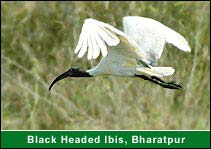 Day
6 : Bharatpur - Agra
Day
6 : Bharatpur - Agra
By Road : 92 km in 2 hr
In the early morning visit the water land to enjoy bird watching.
Return to hotel for breakfast and then proceed by surface to Agra enroute visiting Fatehpur Sikri.
Proceed to visit FATEHPUR SIKRI - The deserted, red Sandstone City, Emperor Akbar built that as his capital and palace in the late 16th century is an exhilarating experience. It a veritable fairytale city and its "ruins" are in pristine condition ... it’s not hard to imagine what the court life must have been like in the days of its grandeur. Also visit the Bulund Darwaza, the largest gateway in the world.
Arrive Agra and transfer to hotel.
AGRA: Two great Mughal monarchs, Akbar and Shah Jahan, transformed the little village of Agra into a befitting second capital of the Mughal Empire - giving it the name Dar-ul-Khilafat {seat of the Emperor}. Today a visitor to Agra is caught up in a world of contrasting edifices, of red sandstone and white marble, narrow galleys and quaint buggies, and that irresistible charm that this favorite city of the Mughals still retains. It is not surprising, that modern Agra still reflects its Mughal heritage most conspicuously. A walk down the narrow bustling streets of the city will introduce the visitor to the wafting aroma of Mughlai cuisine.
In the afternoon proceed for sightseeing of Agra including Agra Fort and Taj Mahal.
Overnight stay at will be at hotel.
Day 7 : Agra - Khajuraho
Breakfast will be at hotel.
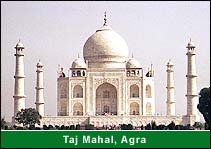
Proceed to Agra and visit Agra Fort- which was built by Akbar In 1525 AD.
Transfer to airport to connect flight for Khajuraho. Arrive Khajuraho and transfer to hotel.
SITUATED IN THE HEART OF INDIA, IN THE STATE OF MADHYA PRADESH, KHAJURAHO IS A FASCINATING VILLAGE WITH A QUAINT, RURAL AMBIENCE AND A RICH CULTURAL HERITAGE, HONOURED BY THE WORLD AS INDIA’S UNIQUE CONTRIBUTION TO HUMAN CIVILISATION. THE CHANDELA DYNASTY BUILT EIGHTY-FIVE TEMPLES HERE. TWENTY REMAIN AS EMBODIMENTS OF INDIAN ARCHITECTURAL AND SCULPTURAL ART AT ITS MOST EVOLVED STATE. EVEN TEN CENTURIES AFTER THEY WERE CONSTRUCTED, THE TEMPLES OF KHAJURAHO REFLECT AN ETERNAL PHILOSOPHY RELEVANT TO ALL MANKIND. THE TEMPLES OF KHAJURAHO IS A WORLD HERITAGE SITE AND BELONG NOT JUST TO INDIA BUT TO THE WORLD. KHAJURAHO IS ONE OF THE FEW MILLENNIUM DESTINATIONS OF THE WORLD.
In the afternoon proceed for sightseeing of world famous Khajuraho temples. Overnight stay will be at Hotel.
Day 8 : Khajuraho - Bandavgarh
By Road : 250 km in 8 hr
In the morning after breakfast proceed by surface for Bandavgarh National Park.
Reach and check in at the resort.
Bandavgarh is a new National Park with a very long history. Set among the Vindhya hills of Madhya Pradesh with an area of 168sq miles (437sq km) it contains a wide variety of habitats and a high density of game, including a large number of Tigers. This is also the White tiger country. These have been found in the old state of Rewa for Many years. Maharaja Martand Singh captured the last known in 1951. This white Tiger, Mohun is now stuffed and on display in the Palace of Maharaja of Rewa. Prior to becoming a National Park, the forests around Bandavgarh had long been maintained as a Shikargah, or game preserve of the Maharaja of Rewa. The Maharaja and his guests carried out hunting - otherwise the wildlife was well protected. It was considered a good omen for Maharaja of Rewa to shoot 109 tigers. His Highness Maharaja Venkat Raman Singh shot 111 Tigers by 1914.
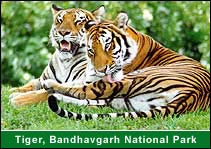 There
are 32 hills in this part of the park, which has a large natural fort at its
center. The fort’s cliffs are 2625 feet (800 meters) high, 1000 feet (300
meters) above the surrounding countryside. Winter temperatures (Nov-mid-February)
vary from almost freezing at night to around 68 degree Fahrenheit in the daytime.
Summer nights are also cooler than the daytime temperatures, which rise to 104
degree Fahrenheit. This park is closed during the breeding season, which coincides
with the monsoon (July-October). Rainfall in the park averages 50 inches (120cm)
per year.
There
are 32 hills in this part of the park, which has a large natural fort at its
center. The fort’s cliffs are 2625 feet (800 meters) high, 1000 feet (300
meters) above the surrounding countryside. Winter temperatures (Nov-mid-February)
vary from almost freezing at night to around 68 degree Fahrenheit in the daytime.
Summer nights are also cooler than the daytime temperatures, which rise to 104
degree Fahrenheit. This park is closed during the breeding season, which coincides
with the monsoon (July-October). Rainfall in the park averages 50 inches (120cm)
per year.
Bandavgarh has been a center of human activity and settlement for over 2000 years, and there are references to it in the ancient books, the Narad-Panch Ratra and the Shiva Purana. Legend has it that Lord Rama, hero of the Hindu epic, the Ramayana, stopped at Bandavgarh on his way back to his homeland after defeating the demon King Ravana of Lanka. Two monkey architects, who had engineered a bridge between the isle of Lanka and the mainland, are said to have built Bandavgarh’s Fort. Later Rama handed it over to his brother Lakshmana who became known as Bandavdhish “The Lord of the Fort”. Lakshmana is the particular God of the fort and is regularly worshipped in a temple there.
The oldest sign of habitation in the park are caves dug into the sandstone to the north of the fort. Several contain Brahmi inscriptions dating from the 1st century BC. Various dynasties have ruled the fort, for example, the Maghas from the 1st century AD, the Vakatakas from the 3rd century AD, from that time onwards Bandavgarh was ruled by a succession of dynasties including the Chandela Kings of Bundelkhand who built the famous temples at Khajuraho. The Baghel Kings, the direct ancestors of the present Royal family of Rewa, established their dynasty at Bandavgarh in the 12th century. It remained their capital till 1617 when the center of court life moved to Rewa, 75 miles (120Kms) to the north. Without royal patronage Bandavgarh became more and more deserted until forest overran the area and it became the royal hunting reserve. This helped to preserve the forest and its wildlife, although the Maharajas made full use of their rights. Each set out to kill the auspicious number of 109 Tigers.
At independence Bandavgarh remained the private property of the Maharaja until he gave it to the state for the formation of the National Park in 1968. After the park was created poaching was brought under control and the number of animals rose dramatically. Small dams and water holes were built to solve the problem of water shortage. Grazing by local cattle was stopped and the village within the park boundaries was relocated. The Tigers in particular prospered and the 1986 extension provided much needed forest to accommodate them.
Bandavgarh is justifiably famous for its Tigers, but it has a wide range of other game. The undergrowth is not as dense as in some northern terai forests, but the best time to see the park inhabitants is still the summer months when water becomes scarce and the undergrowth dies back.
Relax in the evening watching slides on wildlife at the resort.
Overnight will be in the lodge.
Day 9 : Bandavgarh
Breakfast will be in the lodge.
Proceed for full day game viewing inside the jungle. (Two safaris with lunch break in-between)
Overnight will be at the resort.
Day 10 : Bandavgarh - Kanha
By Road : 255 km in 6 hr
After breakfast drive to Kanha.
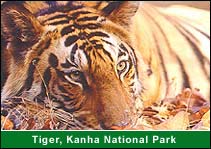
This is the place that has been described by RUDYARD KIPLING in his great book "The Jungle Book". Located in the Mandla district of Madhya Pradesh, Kanha National Park is a tiger reserve that extends over an area of over 940 square km. A horseshoe shaped valley bounded by the spurs of the Mekal presents an interesting topography. Steep rocky escarpments along the edges offer breathtaking views of the valley. Realizing the danger on the Tiger population in the country, the Government started the "Project Tiger" at Kanha and in 1974 the area was declared a Tiger reserve. The park is also the habitat of the high ground Barasingha.
In 1930s, the Kanha area was divided into two sanctuaries - Hallon and Banjar of 250kms to 300kms each. Though one of these was subsequently disbanded .The area remained a protected one until 1947. Depletion of the tiger population in the year that followed led to the area being made an absolute sanctuary in 1952.
Patient watching should reward the visitor, with a sight of Indian Fox, Sloth bear, Striped hyena, Jungle cut, Lepord, Mouse Deer, Chausingha or four horned antelope, Nilgai, Ratel and Porcupine Kanha has some 200 species of birds. Watchers should station themselves in the hills, where the mixed and bamboo forests harbour many species and in the grassy forest clearings. Water birds can be seen near the park’s many rivulets and at Sarvantal, a pool that is frequented by water birds and the area in front of the museum.
Reach in the afternoon and relax at the resort.
Overnight will be at the Kanha Resort.
Day 11 : Kanha
Breakfast will be at the resort.
Proceed for full day game viewing inside the jungle. (Two safaris with lunch break in-between)
Overnight will be at the resort.
Day 12 : Kanha
Breakfast will be at the resort.
Proceed for full day game viewing inside the jungle. (Two safaris with lunch break in-between)
Overnight will be at the resort.
Day 13 : Kanha - Nagpur
In the morning proceed for safari in the park. Have breakfast at the resort or during the safari and freshen up at the resort.
Start for Nagpur and reach by evening.
Relax for the night at Nagpur.
Day 14 : Nagpur - Delhi
Breakfast will be at hotel.
Transfer to airport for flight to Delhi. Spend day relaxing at the hotel or spending time at local markets. Overnight will be at Delhi.
Day 15 : Delhi - Varanasi
Breakfast will be at hotel.
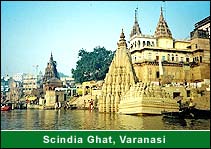
Transfer in time to airport for flight to Varanasi. Upon arrival at Varanasi, you will be met and transferred to hotel.
VARANASI IS THE WORLD’S MOST ANCIENT LIVING CITY. SUNRISE ON THE RIVERFRONT, AS SEEN FROM A BOAT, CAN BE SPIRITUALLY UPLIFTING SIGHT. CROWDED WITH TEMPLES, AND ITS LABYRINTH OF STREETS, THE CITY ATTRACTS THE MAXIMUM NUMBER OF TOURISTS. THE RELIGIOUS CAPITAL OF HINDUISM, VARANASI IS THE CARPET MANUFACTURING PLACE OF INDIA. IT WAS PREVIOUSLY KNOWN AS KASHI - THE CITY THAT ILLUMINATES. THE PRESENT NAME IS DERIVED FROM THE FACT THAT THE CITY IS AT THE CONFLUENCE OF THE RIVERS VARUNA AND ASI.
Visit Sarnath - 5 miles out of Varanasi for a day excursion: One of the holiest Buddhist sites in the world, where Buddha preached his first Sermon in 590 BC. Witness the ruins of a once flourishing Buddhist monastery and then visit a fine Museum which houses an excellent collection of Buddhist art and sculptures found at the site.
Proceed for sightseeing tour of Varanasi.
Visit Bharat Mata Temple, which features a big relief map of Mother India engraved in marble. Also visit the 18th century Durga Temple, commonly known as the Monkey Temple due to the huge population of the monkeys. Proceed to the Tulsi manas Temple, crafted from white marble which features the entire Ramayana inscribed on its walls. Also visit the BHU considered as the biggest residential university in Asia. The University Campus houses an Art Gallery and the Mosque of Mughal Emperor Aurangzeb.
Overnight will be spent at Varanasi.
Day 16 : Varanasi - Kathmandu
Drive early morning to Daswamedh Ghat and take a boat ride on the sacred river Ganges to see the cremation Ghats and witness the living traditions of one of the world's oldest and most important religions. (To start at 0500 hrs. for the best lifetime experience) For you to appreciate this remarkable city, we'll transfer you to the banks of the River Ganges before the sun rises. Board a boat with your guide and proceed to the middle of the river, where at sunrise the sight unfolds before you. Thousands of faithful come daily to the banks to bathe and pray while in the background, temples and palaces rise in tiers from the water's edge. Then return for a walk through the cobblestone streets along the banks of "Ganga". As shops are opening, the place now becomes a beehive of activity as the faithful are coming and going. Also visit the Kashi Vishwanath Temple while returning to the hotel.
Return for breakfast to the hotel.
Proceed to the airport for flight to Kathmandu after a leisurely breakfast.
Reach Katmandu.
The Katmandu Valley, the political, commercial and cultural hub of Nepal, is the first for the majority of visitors to Nepal. Once a separate kingdom in itself, it contains three fabled cities - Katmandu, Patan and Bhaktapur. Each is an artistic exposition of graceful temples, elegant palaces, brick paved courtyards and quaint streets. There are seven UNESCO World Heritage sites in the valley.
Day will be free to relax and shop around. Overnight will be at Kathmandu.
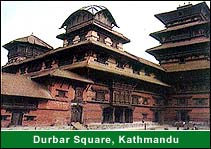 Day
17 : Kathmandu
Day
17 : Kathmandu
Breakfast will be at the hotel. Day tour will be covering Swambhunath and Kathmandu Durbar Square.
It is the historic seat of royalty. The Durbar Square, with its old temples and palaces, epitomizes the religious and cultural life of the people. It is here that kings of Nepal are crowned and their coronations solemnized. Interesting things to see here are: Taleju Temple built by King Mahendra Malla in 1549 AD, the temple of Kal Bhairav, the God of destruction, Nautalle Durbar, Coronation Nasal Chowk, the Gaddi Baithak, the statue of King Pratap Malla, the Big Drum and the Jagannath Temple.
On the right hand corner, a large wooden lattice screen hides an enormous gilded face of Sweta Bhairav. The screen is removed only during the Indra Jatra festival. There are also the Numismatic Museum and Tribhuvan Museum inside the Hanuman Dhoka Palace building. Photography is prohibited inside the museum. Both the museums remain closed on Sundays, Mondays and government holidays.
The Buddhist temple of Swayambhunath situated on the top of a hill west of the city, is on the most popular and instantly recognisable symbols of Nepal. The temple is colloquially know as the 'monkey templ' after the large tribe of handsome monkeys which guards the hill and amuses visitors and devotees with tricks, including slinding gracefully down the double banisters of the main stairway to the temple. The roving monkeys quickly snatch up any offerings of food made by devotes and will just as quickly grab anything you may be carrying.
Overnight will be at Katmandu.
Day 18 : Kathmandu
Breakfast will be at hotel.
Proceed for a visit to PASUPATINATH & BOUDDHANATH.
Situated 5 km east of Kathmandu, the temple of Lord Shiva, Pashupatinath, with two tiered golden roof and silver door is considered one of the holiest shrines for Hindu. It is Top Hindu temple of the world. Although only Hindus are allowed inside the temple, visitors can clearly see the temple and the activities performed in the temple premises from the eastern bank of the Bagmati River. The Stupa of Bouddhanath lies 8 km east of Kathmandu. This ancient colossal Stupa is one of the biggest in the world, and the center of Tibetan Buddhism in the world.
Proceed for a full day visit of PATAN & BHAKTAPUR.
Patan, the second-largest city in the valley, lies just across the Bagmati River from Kathmandu, but it's a much quieter and less frenetic place to visit. The city is justly proud of its temples and artisans and it is their handiwork that provides the focus of the stunning Durbar Square - choc-a-block with the largest display of Newari architecture in Nepal. It includes the Royal Palace, which contains a richly decorated bathtub, and the two-tiered brick Jagannarayan Temple.
Look up to the roof struts to see carvings of figures engaged in quite athletic acts of intercourse. A few minutes' walk north of the square is the Golden Temple, a Buddhist monastery guarded by sacred tortoises that potter around the courtyard; and the Kumbeshawar, reputedly the oldest (1392) temple in Patan. South of the square is an area of charming streets lined with metal smiths and Brassware shops. Patan's other attractions are flung further. Among them is a collection of four stupas, thought to have been built over 2500 years ago, and Nepal's only zoo, which features a reasonable assortment of rhinos, tigers, leopards and bird life. Palm readers gather in the park outside - they may be able to point out which animal you'll be reincarnated as.
Proceed to Bhaktapur.
Situated at an altitude of 1,401m, Bhaktapur covers an area of four square miles. Bhaktapur or the city of Devotees still retains a medieval charm and visitors to this ancient town are treated to myriad wonders of cultural and artistic achievements. The past glory of the Malla rulers continues to be reflected at the Durbar Square. Pottery and weaving are its traditional industries. Bhaktapur is famous for woodcarving, the Bhadgaolen topi (cap) and curd. The city lies about 14 km east of Kathmandu.
Spend the rest of the day visiting the intricately carved buildings and other areas that interest you.
Overnight will be at Kathmandu.
Day 19 : Katmandu - Pokhra
By Road : 200 km/5 hr
Proceed to Pokhra after breakfast.
Pokhra is a remarkable place of natural beauty. Situated at an altitude of 827m from the sea level and 200km west of Kathmandu valley, the city is known as a center of adventure. The enchanting city with a population of around 95,000 has several beautiful lakes and offers stunning panoramic views of Himalayan peaks. The serenity of lakes and the magnificence of the Himalayas rising behind them create an ambience of peace and magic. So today the city has not only become the starting point for most popular trekking and rafting destinations but also a place to relax and enjoy the beauty of nature.
Pokhra is part of a once vibrant trade route extending between India and Tibet. To this day, mule trains can be seen camped on the outskirts of the town, bringing goods to trade from remote regions of the Himalaya. This is the land of Magars and Gurungs, hardworking farmers and valorous warriors who have earned worldwide fame as Gurkha soldiers. The Thakalis, another important ethnic group here, are known for their entrepreneurship.
The climate of Pokhara is slightly warmer than Kathmandu with daytime temperature hovering around 15 degrees Celsius in winter and 35 degrees in summer. The monsoon season which lasts from mid-June to mid-September is very wet; in fact Pokhara records the highest rainfall in the country. Best time to visit is between October and April.
The activities of foreign visitors to Pokhra focus around two districts known as Damside and Lakeside (or Pardi and Baidam, in Nepali, respectively). These two areas, with their strips of hotels and restaurants, are a few kilometers south-west of the main Pokhra bazaar.
Reach Pokhra at 2:30 pm, transfer to hotel, refresh & relax with the spectacular panorama of Annapurna range forming the backdrop. Stretching from the east to west, the Annapurna massif includes Annapurna I to IV and Annapurna South. Although the highest among them is Annapurna I (8091m), it is Machhapuchhre (the fishtail), which dominates all others in this neighborhood. Boastfully levitating in the skyline, the fish-tailed pinnacle is the archetypal snow-capped, needle-pointed mountain.
In the later day, enjoy the stroll around the valley with the boat ride (optional) on the famous PHEWA LAKE.
Overnight will be in Pokhara.
Day 20 : Pokhra
Start your day with the early morning visit to Sarangkot for the fabulous sunrise.
Drive back to hotel for breakfast after the spectacular sunrise
Visit the famous Devi’s Fall (also known as Devin’s or David’s) locally known as Patale Chhango (Hell’s Fall), an awesome waterfall lying about 2 km south-west of Pokhara Airport on the highway to Tansen. Legend has it that a trekker (Devin, David…) was washed away by the Pardi Khola and mysteriously disappeared down into an underground passage beneath the fall.
Bindhyabasubu Temple at the old bazaar, Seti Gandaki, the boisterous river running completely underground at the places, Mahendra cave (House of Bats), the natures’ wonder at Pokhara & Pokhara Museum
After lunch, start our exploration of the city by driving to the Begnas Lake & Rupa Lake located 15 Km from Pokhara divided by a forested hillock called Panchabhaiya Danda, offering the perfect nature retreat with their relative seclusion.
Overnight will be in Pokhara.
Day 21 : Pokhra - Kathmandu
Breakfast will be at hotel.
Proceed to airport for flight to Kathmandu. Reach and take connecting flight to Delhi.
Reach Delhi and transfer to hotel for the day. Proceed for last minute shopping before proceeding for the FAREWELL DINNER and then onwards to airport for flight home.
TOUR ENDS
Wildlife Tour of India and Nepal
Duration : 20 Nights / 21 Days
Destination Covered : Delhi - Jaipur - Ranthambore - Bharatpur - Agra -Khajuraho - Bandhavgarh - Kanha - Nagpur - Delhi - Varanasi - Kathmandu - Pokra - - Kathmandu - Delhi
 Day
1 : Delhi
Day
1 : DelhiCompany representatives will receive you on arrival at the international airport in Delhi late in the night or midnight. Transfer to your hotel. Relax.
DELHI, the capital of kingdoms and empires is now a sprawling metropolis with a fascinating blend of the past and the present. It is a perfect introduction to the composite culture of an ancient land. A window to the kaleidoscope - that is India.
Overnight will be at Delhi.
Day 2 : Delhi - Jaipur
By Road : 260 Km in 6 hr
After breakfast drive to beautiful Pink City - Jaipur.
Reach and check in at hotel.
JAIPUR - The origins of the beautiful city of Jaipur can be traced back to the eighteenth century, during the reign of Jai Singh II who ascended the Amber throne in 1699. Jaipur today, epitomizes the spirit of Rajputana. In-spite of growing into a bustling metropolis, it still retains its character and history - A beautiful fusion of the yesteryears and modernity. It is popularly known as the Pink City because of the extensive use of the locally abundant pink plastered stone, painted so in honor of the visit of the royal consort of Queen Victoria. Jaipur thrills the soul with its massive forts, magnificent palaces, exquisite temples and lush gardens.
Proceed for excursion to Amber Fort in the outskirts of Jaipur. Elephant ride ascent to the fort.
AMBER FORT PALACE - Amber is the classic romantic Rajasthani fort palace. Its construction was started by Man Singh I in 1592, and completed by his descendent Jai Singh I. Its forbidding exterior belies an inner paradise where a beautiful fusion of Mughal and Hindu styles finds its ultimate expression.
Explore the city markets. Overnight will be at Jaipur.
Day 3 : Jaipur - Ranthambhore
By Road : 156 Km in 3 hr
Proceed for sightseeing of the city after breakfast.
CITY PALACE - A delightful blend of Mughal and traditional Rajasthani architecture, the City Palace sprawls over one-seventh of the area in the walled city. It houses the Chandra Mahal, Shri Govind Dev Temple and the City Palace Museum.
JANTAR MANTAR - This is the largest and the best preserved of the five observatories built by Jai Singh II in different parts of the country. This observatory consisting of outsized astronomical instruments is still in use.
 HAWA
MAHAL - The ornamental facade of this "Palace of Winds" is a prominent
landmark in Jaipur. It is a five-storey structure of sandstone plastered pink
encrusted with fine trelliswork and elaborate balconies. The palace has 953
niches and windows. Built in 1799 by Pratap Singh, the Mahal was a royal grandstand
for the palace women.
HAWA
MAHAL - The ornamental facade of this "Palace of Winds" is a prominent
landmark in Jaipur. It is a five-storey structure of sandstone plastered pink
encrusted with fine trelliswork and elaborate balconies. The palace has 953
niches and windows. Built in 1799 by Pratap Singh, the Mahal was a royal grandstand
for the palace women. Proceed to Ranthambhore and reach by late afternoon.
Evening free at the resort and you can relax or watch some slides on the tiger.
Ranthambhore Tiger Reserve, at the junction of the Aravalis and the Vindhyas, is a unique example of natural and historical richness, standing out conspicuously in the vast, arid and denuded tract of eastern Rajasthan, barely 14 kilometers from Sawai Madhopur. Get in tune with nature for a luxury holiday in the heart of the jungle. Ranthambhore <the_town.html> - perhaps the best place in the world to sight a tiger in the wild. The Ranthambhore National Park <the_sanctuary.html> has had more Tiger sightings than any other National Park in the country. It has come to be known as "The land of the Tiger", where most of the documented footage of this majestic beast has been recorded.
It spreads over a highly undulating topography varying from gentle to steep slopes; from flat topped hills of the Vindhyas to the conical hillocks and sharp ridges of the Aravalis, from wide and flat valleys to narrow rocky gorges. An important geological feature the ‘Great Boundary Fault’ where the Vindhya plateaus meet the Aravali hill ranges, meanders through the Reserve. The National Park is bound by the rivers Chambal in the south and Banas in the north.
Ranthambhore forest is of tropical dry deciduous type, further classified as Dhok climax forest because of the predominance of Dhok (Anogeissus pendulla) found nearly everywhere. Dhok is an extremely hardy tree, capable of withstanding prolonged droughts. The leaves of this tree are good fodder and they are browsed by herbivores, and form a significant part of their diet. Even the dry, fallen leaves, eaten by them, are rich source of nutrition.
Palas or Cheela or the Flame of the Forest (Butea monosperms) blooms magnificently around mid-April. During the period, Kachida and Anatpura provide an amazing view, like a forest on fire. Around Kamaldhar massive Gum trees (Sterculia urens) with smooth white trunk stand out conspicuously. Similarly, Gurjan (Lannea coromandelica) with greyish trunks at the banks of the lakes and soft wood Salar (Boswellia serrata) dotted atop hills are noticeable.
The lakes abound with aquatic vegetation including duck weeds, lilies and lotus.
A haven for a multitude of wild animals, the Park boasts of playing host to tigers, leopards, the elusive caracals, hyenas, sloth bears, wild boars, crocodiles and so on. Besides, there are over 300 species of birds, from the majestic Crested Serpent Eagle to the exotic Golden Oriole.
Tiger, at the apex of the food chain, lord over the kingdom in a subtle way. Solitary by nature, it operates in stealth. Therefore tiger sightings, frequent as they are, are always a matter of chance. However, even evidences of tiger's activities are very exciting.
Overnight will be at resort.
Day 4 : Ranthambore
Breakfast will be at the lodge.
Proceed for full day game viewing inside the jungle. (Two safaris with lunch break in-between)
Overnight will be at the resort.
 Day
5 : Ranthambore - Bharatpur
Day
5 : Ranthambore - BharatpurKeoladeo Ghana National Park
By Road: 200 km in 4 hr
Proceed to Bharatpur after breakfast
Just 176 km from Delhi is a very special wilderness - the Keoladeo Ghana National Park, one of the finest water-bird sanctuaries in the world. The Maharaja of Bharatpur artificially created the lake and wetland in the 19th century. By building small dykes and dams and diverting water from an irrigation canal, he converted this low-lying area into a fine wild fowl shooting preserve. In a few years, the new wetland surrounded by marginal forests was able to support thousands of water birds.
Commonly referred to as Bharatpur, the Park is a delight for bird watchers. Over 375 species of birds are found here and raised paths, camouflaged by babul trees and undergrowth make viewing easy. A quiet ride by boat in the early hours of the morning is also unforgettable experience. The cacophony is unbelievable as painted storks, open bills, spoonbills, egrets, cormorants, white ibis and multitudes of others, tend their young. Jacanas with their iridescent colors and elegant tail feathers and purple moorhen can be seen delicately treading over the floating vegetation.
Every year Bharatpur waits with bated breath for the arrival of the Siberian cranes. There are only two wintering places for this rare species one in Iran and the other Bharatpur and these beautiful birds with their distinctive red beaks and facial patches, fly over 6400 km from their summer retreats.
Colorful kingfishers, graceful pelicans rare Siberian cranes and Trans- continental fliers - the migratory water - fowl are amongst the 375 species of birds found in the Keoladeo National Park. The most spectacular nesting is that of the egrets, storks, herons and cormorants, which make over 10,000 nests every year. This makes outstanding bird havens of the world. The park covers an area of 28.73km.
The story of Bharatpur Bird Sanctuary is incomplete without an account of the migratory waterfowl. The most prominent waterfowl coming to this park are bareheaded and greyleg geese. Ducks also create a lot of fluttering in the lakes. The ducks usually found here are pintail, widgeon, common shelduck, shoveler, garganey, teal, etc.
Attracted by the influx of the waterfowl the predatory birds-tawny eagles, spotted eagles short-toed eagles imperial eagles and fishing eagle also arrive. They all form the apex of the biological pyramid of the sanctuary and complete the avian food chain of the ecosystem. There are large herds of the nilgai, chital, wild boar and fear cows in addition to a few herds of sambar.
Reach and check in at the hotel. Proceed on RICKSHAW for viewing the birds. RICKSHAW PULLERS have been trained by the forest department in bird watching and are knowledgeable.
Return to the lodge in the evening and relax.
Overnight will be at Bharatpur.
 Day
6 : Bharatpur - Agra
Day
6 : Bharatpur - AgraBy Road : 92 km in 2 hr
In the early morning visit the water land to enjoy bird watching.
Return to hotel for breakfast and then proceed by surface to Agra enroute visiting Fatehpur Sikri.
Proceed to visit FATEHPUR SIKRI - The deserted, red Sandstone City, Emperor Akbar built that as his capital and palace in the late 16th century is an exhilarating experience. It a veritable fairytale city and its "ruins" are in pristine condition ... it’s not hard to imagine what the court life must have been like in the days of its grandeur. Also visit the Bulund Darwaza, the largest gateway in the world.
Arrive Agra and transfer to hotel.
AGRA: Two great Mughal monarchs, Akbar and Shah Jahan, transformed the little village of Agra into a befitting second capital of the Mughal Empire - giving it the name Dar-ul-Khilafat {seat of the Emperor}. Today a visitor to Agra is caught up in a world of contrasting edifices, of red sandstone and white marble, narrow galleys and quaint buggies, and that irresistible charm that this favorite city of the Mughals still retains. It is not surprising, that modern Agra still reflects its Mughal heritage most conspicuously. A walk down the narrow bustling streets of the city will introduce the visitor to the wafting aroma of Mughlai cuisine.
In the afternoon proceed for sightseeing of Agra including Agra Fort and Taj Mahal.
Overnight stay at will be at hotel.
Day 7 : Agra - Khajuraho
Breakfast will be at hotel.

Proceed to Agra and visit Agra Fort- which was built by Akbar In 1525 AD.
Transfer to airport to connect flight for Khajuraho. Arrive Khajuraho and transfer to hotel.
SITUATED IN THE HEART OF INDIA, IN THE STATE OF MADHYA PRADESH, KHAJURAHO IS A FASCINATING VILLAGE WITH A QUAINT, RURAL AMBIENCE AND A RICH CULTURAL HERITAGE, HONOURED BY THE WORLD AS INDIA’S UNIQUE CONTRIBUTION TO HUMAN CIVILISATION. THE CHANDELA DYNASTY BUILT EIGHTY-FIVE TEMPLES HERE. TWENTY REMAIN AS EMBODIMENTS OF INDIAN ARCHITECTURAL AND SCULPTURAL ART AT ITS MOST EVOLVED STATE. EVEN TEN CENTURIES AFTER THEY WERE CONSTRUCTED, THE TEMPLES OF KHAJURAHO REFLECT AN ETERNAL PHILOSOPHY RELEVANT TO ALL MANKIND. THE TEMPLES OF KHAJURAHO IS A WORLD HERITAGE SITE AND BELONG NOT JUST TO INDIA BUT TO THE WORLD. KHAJURAHO IS ONE OF THE FEW MILLENNIUM DESTINATIONS OF THE WORLD.
In the afternoon proceed for sightseeing of world famous Khajuraho temples. Overnight stay will be at Hotel.
Day 8 : Khajuraho - Bandavgarh
By Road : 250 km in 8 hr
In the morning after breakfast proceed by surface for Bandavgarh National Park.
Reach and check in at the resort.
Bandavgarh is a new National Park with a very long history. Set among the Vindhya hills of Madhya Pradesh with an area of 168sq miles (437sq km) it contains a wide variety of habitats and a high density of game, including a large number of Tigers. This is also the White tiger country. These have been found in the old state of Rewa for Many years. Maharaja Martand Singh captured the last known in 1951. This white Tiger, Mohun is now stuffed and on display in the Palace of Maharaja of Rewa. Prior to becoming a National Park, the forests around Bandavgarh had long been maintained as a Shikargah, or game preserve of the Maharaja of Rewa. The Maharaja and his guests carried out hunting - otherwise the wildlife was well protected. It was considered a good omen for Maharaja of Rewa to shoot 109 tigers. His Highness Maharaja Venkat Raman Singh shot 111 Tigers by 1914.
 There
are 32 hills in this part of the park, which has a large natural fort at its
center. The fort’s cliffs are 2625 feet (800 meters) high, 1000 feet (300
meters) above the surrounding countryside. Winter temperatures (Nov-mid-February)
vary from almost freezing at night to around 68 degree Fahrenheit in the daytime.
Summer nights are also cooler than the daytime temperatures, which rise to 104
degree Fahrenheit. This park is closed during the breeding season, which coincides
with the monsoon (July-October). Rainfall in the park averages 50 inches (120cm)
per year.
There
are 32 hills in this part of the park, which has a large natural fort at its
center. The fort’s cliffs are 2625 feet (800 meters) high, 1000 feet (300
meters) above the surrounding countryside. Winter temperatures (Nov-mid-February)
vary from almost freezing at night to around 68 degree Fahrenheit in the daytime.
Summer nights are also cooler than the daytime temperatures, which rise to 104
degree Fahrenheit. This park is closed during the breeding season, which coincides
with the monsoon (July-October). Rainfall in the park averages 50 inches (120cm)
per year. Bandavgarh has been a center of human activity and settlement for over 2000 years, and there are references to it in the ancient books, the Narad-Panch Ratra and the Shiva Purana. Legend has it that Lord Rama, hero of the Hindu epic, the Ramayana, stopped at Bandavgarh on his way back to his homeland after defeating the demon King Ravana of Lanka. Two monkey architects, who had engineered a bridge between the isle of Lanka and the mainland, are said to have built Bandavgarh’s Fort. Later Rama handed it over to his brother Lakshmana who became known as Bandavdhish “The Lord of the Fort”. Lakshmana is the particular God of the fort and is regularly worshipped in a temple there.
The oldest sign of habitation in the park are caves dug into the sandstone to the north of the fort. Several contain Brahmi inscriptions dating from the 1st century BC. Various dynasties have ruled the fort, for example, the Maghas from the 1st century AD, the Vakatakas from the 3rd century AD, from that time onwards Bandavgarh was ruled by a succession of dynasties including the Chandela Kings of Bundelkhand who built the famous temples at Khajuraho. The Baghel Kings, the direct ancestors of the present Royal family of Rewa, established their dynasty at Bandavgarh in the 12th century. It remained their capital till 1617 when the center of court life moved to Rewa, 75 miles (120Kms) to the north. Without royal patronage Bandavgarh became more and more deserted until forest overran the area and it became the royal hunting reserve. This helped to preserve the forest and its wildlife, although the Maharajas made full use of their rights. Each set out to kill the auspicious number of 109 Tigers.
At independence Bandavgarh remained the private property of the Maharaja until he gave it to the state for the formation of the National Park in 1968. After the park was created poaching was brought under control and the number of animals rose dramatically. Small dams and water holes were built to solve the problem of water shortage. Grazing by local cattle was stopped and the village within the park boundaries was relocated. The Tigers in particular prospered and the 1986 extension provided much needed forest to accommodate them.
Bandavgarh is justifiably famous for its Tigers, but it has a wide range of other game. The undergrowth is not as dense as in some northern terai forests, but the best time to see the park inhabitants is still the summer months when water becomes scarce and the undergrowth dies back.
Relax in the evening watching slides on wildlife at the resort.
Overnight will be in the lodge.
Day 9 : Bandavgarh
Breakfast will be in the lodge.
Proceed for full day game viewing inside the jungle. (Two safaris with lunch break in-between)
Overnight will be at the resort.
Day 10 : Bandavgarh - Kanha
By Road : 255 km in 6 hr
After breakfast drive to Kanha.

This is the place that has been described by RUDYARD KIPLING in his great book "The Jungle Book". Located in the Mandla district of Madhya Pradesh, Kanha National Park is a tiger reserve that extends over an area of over 940 square km. A horseshoe shaped valley bounded by the spurs of the Mekal presents an interesting topography. Steep rocky escarpments along the edges offer breathtaking views of the valley. Realizing the danger on the Tiger population in the country, the Government started the "Project Tiger" at Kanha and in 1974 the area was declared a Tiger reserve. The park is also the habitat of the high ground Barasingha.
In 1930s, the Kanha area was divided into two sanctuaries - Hallon and Banjar of 250kms to 300kms each. Though one of these was subsequently disbanded .The area remained a protected one until 1947. Depletion of the tiger population in the year that followed led to the area being made an absolute sanctuary in 1952.
Patient watching should reward the visitor, with a sight of Indian Fox, Sloth bear, Striped hyena, Jungle cut, Lepord, Mouse Deer, Chausingha or four horned antelope, Nilgai, Ratel and Porcupine Kanha has some 200 species of birds. Watchers should station themselves in the hills, where the mixed and bamboo forests harbour many species and in the grassy forest clearings. Water birds can be seen near the park’s many rivulets and at Sarvantal, a pool that is frequented by water birds and the area in front of the museum.
Reach in the afternoon and relax at the resort.
Overnight will be at the Kanha Resort.
Day 11 : Kanha
Breakfast will be at the resort.
Proceed for full day game viewing inside the jungle. (Two safaris with lunch break in-between)
Overnight will be at the resort.
Day 12 : Kanha
Breakfast will be at the resort.
Proceed for full day game viewing inside the jungle. (Two safaris with lunch break in-between)
Overnight will be at the resort.
Day 13 : Kanha - Nagpur
In the morning proceed for safari in the park. Have breakfast at the resort or during the safari and freshen up at the resort.
Start for Nagpur and reach by evening.
Relax for the night at Nagpur.
Day 14 : Nagpur - Delhi
Breakfast will be at hotel.
Transfer to airport for flight to Delhi. Spend day relaxing at the hotel or spending time at local markets. Overnight will be at Delhi.
Day 15 : Delhi - Varanasi
Breakfast will be at hotel.

Transfer in time to airport for flight to Varanasi. Upon arrival at Varanasi, you will be met and transferred to hotel.
VARANASI IS THE WORLD’S MOST ANCIENT LIVING CITY. SUNRISE ON THE RIVERFRONT, AS SEEN FROM A BOAT, CAN BE SPIRITUALLY UPLIFTING SIGHT. CROWDED WITH TEMPLES, AND ITS LABYRINTH OF STREETS, THE CITY ATTRACTS THE MAXIMUM NUMBER OF TOURISTS. THE RELIGIOUS CAPITAL OF HINDUISM, VARANASI IS THE CARPET MANUFACTURING PLACE OF INDIA. IT WAS PREVIOUSLY KNOWN AS KASHI - THE CITY THAT ILLUMINATES. THE PRESENT NAME IS DERIVED FROM THE FACT THAT THE CITY IS AT THE CONFLUENCE OF THE RIVERS VARUNA AND ASI.
Visit Sarnath - 5 miles out of Varanasi for a day excursion: One of the holiest Buddhist sites in the world, where Buddha preached his first Sermon in 590 BC. Witness the ruins of a once flourishing Buddhist monastery and then visit a fine Museum which houses an excellent collection of Buddhist art and sculptures found at the site.
Proceed for sightseeing tour of Varanasi.
Visit Bharat Mata Temple, which features a big relief map of Mother India engraved in marble. Also visit the 18th century Durga Temple, commonly known as the Monkey Temple due to the huge population of the monkeys. Proceed to the Tulsi manas Temple, crafted from white marble which features the entire Ramayana inscribed on its walls. Also visit the BHU considered as the biggest residential university in Asia. The University Campus houses an Art Gallery and the Mosque of Mughal Emperor Aurangzeb.
Overnight will be spent at Varanasi.
Day 16 : Varanasi - Kathmandu
Drive early morning to Daswamedh Ghat and take a boat ride on the sacred river Ganges to see the cremation Ghats and witness the living traditions of one of the world's oldest and most important religions. (To start at 0500 hrs. for the best lifetime experience) For you to appreciate this remarkable city, we'll transfer you to the banks of the River Ganges before the sun rises. Board a boat with your guide and proceed to the middle of the river, where at sunrise the sight unfolds before you. Thousands of faithful come daily to the banks to bathe and pray while in the background, temples and palaces rise in tiers from the water's edge. Then return for a walk through the cobblestone streets along the banks of "Ganga". As shops are opening, the place now becomes a beehive of activity as the faithful are coming and going. Also visit the Kashi Vishwanath Temple while returning to the hotel.
Return for breakfast to the hotel.
Proceed to the airport for flight to Kathmandu after a leisurely breakfast.
Reach Katmandu.
The Katmandu Valley, the political, commercial and cultural hub of Nepal, is the first for the majority of visitors to Nepal. Once a separate kingdom in itself, it contains three fabled cities - Katmandu, Patan and Bhaktapur. Each is an artistic exposition of graceful temples, elegant palaces, brick paved courtyards and quaint streets. There are seven UNESCO World Heritage sites in the valley.
Day will be free to relax and shop around. Overnight will be at Kathmandu.
 Day
17 : Kathmandu
Day
17 : KathmanduBreakfast will be at the hotel. Day tour will be covering Swambhunath and Kathmandu Durbar Square.
It is the historic seat of royalty. The Durbar Square, with its old temples and palaces, epitomizes the religious and cultural life of the people. It is here that kings of Nepal are crowned and their coronations solemnized. Interesting things to see here are: Taleju Temple built by King Mahendra Malla in 1549 AD, the temple of Kal Bhairav, the God of destruction, Nautalle Durbar, Coronation Nasal Chowk, the Gaddi Baithak, the statue of King Pratap Malla, the Big Drum and the Jagannath Temple.
On the right hand corner, a large wooden lattice screen hides an enormous gilded face of Sweta Bhairav. The screen is removed only during the Indra Jatra festival. There are also the Numismatic Museum and Tribhuvan Museum inside the Hanuman Dhoka Palace building. Photography is prohibited inside the museum. Both the museums remain closed on Sundays, Mondays and government holidays.
The Buddhist temple of Swayambhunath situated on the top of a hill west of the city, is on the most popular and instantly recognisable symbols of Nepal. The temple is colloquially know as the 'monkey templ' after the large tribe of handsome monkeys which guards the hill and amuses visitors and devotees with tricks, including slinding gracefully down the double banisters of the main stairway to the temple. The roving monkeys quickly snatch up any offerings of food made by devotes and will just as quickly grab anything you may be carrying.
Overnight will be at Katmandu.
Day 18 : Kathmandu
Breakfast will be at hotel.
Proceed for a visit to PASUPATINATH & BOUDDHANATH.
Situated 5 km east of Kathmandu, the temple of Lord Shiva, Pashupatinath, with two tiered golden roof and silver door is considered one of the holiest shrines for Hindu. It is Top Hindu temple of the world. Although only Hindus are allowed inside the temple, visitors can clearly see the temple and the activities performed in the temple premises from the eastern bank of the Bagmati River. The Stupa of Bouddhanath lies 8 km east of Kathmandu. This ancient colossal Stupa is one of the biggest in the world, and the center of Tibetan Buddhism in the world.
Proceed for a full day visit of PATAN & BHAKTAPUR.
Patan, the second-largest city in the valley, lies just across the Bagmati River from Kathmandu, but it's a much quieter and less frenetic place to visit. The city is justly proud of its temples and artisans and it is their handiwork that provides the focus of the stunning Durbar Square - choc-a-block with the largest display of Newari architecture in Nepal. It includes the Royal Palace, which contains a richly decorated bathtub, and the two-tiered brick Jagannarayan Temple.
Look up to the roof struts to see carvings of figures engaged in quite athletic acts of intercourse. A few minutes' walk north of the square is the Golden Temple, a Buddhist monastery guarded by sacred tortoises that potter around the courtyard; and the Kumbeshawar, reputedly the oldest (1392) temple in Patan. South of the square is an area of charming streets lined with metal smiths and Brassware shops. Patan's other attractions are flung further. Among them is a collection of four stupas, thought to have been built over 2500 years ago, and Nepal's only zoo, which features a reasonable assortment of rhinos, tigers, leopards and bird life. Palm readers gather in the park outside - they may be able to point out which animal you'll be reincarnated as.
Proceed to Bhaktapur.
Situated at an altitude of 1,401m, Bhaktapur covers an area of four square miles. Bhaktapur or the city of Devotees still retains a medieval charm and visitors to this ancient town are treated to myriad wonders of cultural and artistic achievements. The past glory of the Malla rulers continues to be reflected at the Durbar Square. Pottery and weaving are its traditional industries. Bhaktapur is famous for woodcarving, the Bhadgaolen topi (cap) and curd. The city lies about 14 km east of Kathmandu.
Spend the rest of the day visiting the intricately carved buildings and other areas that interest you.
Overnight will be at Kathmandu.
Day 19 : Katmandu - Pokhra
By Road : 200 km/5 hr
Proceed to Pokhra after breakfast.
Pokhra is a remarkable place of natural beauty. Situated at an altitude of 827m from the sea level and 200km west of Kathmandu valley, the city is known as a center of adventure. The enchanting city with a population of around 95,000 has several beautiful lakes and offers stunning panoramic views of Himalayan peaks. The serenity of lakes and the magnificence of the Himalayas rising behind them create an ambience of peace and magic. So today the city has not only become the starting point for most popular trekking and rafting destinations but also a place to relax and enjoy the beauty of nature.
Pokhra is part of a once vibrant trade route extending between India and Tibet. To this day, mule trains can be seen camped on the outskirts of the town, bringing goods to trade from remote regions of the Himalaya. This is the land of Magars and Gurungs, hardworking farmers and valorous warriors who have earned worldwide fame as Gurkha soldiers. The Thakalis, another important ethnic group here, are known for their entrepreneurship.
The climate of Pokhara is slightly warmer than Kathmandu with daytime temperature hovering around 15 degrees Celsius in winter and 35 degrees in summer. The monsoon season which lasts from mid-June to mid-September is very wet; in fact Pokhara records the highest rainfall in the country. Best time to visit is between October and April.
The activities of foreign visitors to Pokhra focus around two districts known as Damside and Lakeside (or Pardi and Baidam, in Nepali, respectively). These two areas, with their strips of hotels and restaurants, are a few kilometers south-west of the main Pokhra bazaar.
Reach Pokhra at 2:30 pm, transfer to hotel, refresh & relax with the spectacular panorama of Annapurna range forming the backdrop. Stretching from the east to west, the Annapurna massif includes Annapurna I to IV and Annapurna South. Although the highest among them is Annapurna I (8091m), it is Machhapuchhre (the fishtail), which dominates all others in this neighborhood. Boastfully levitating in the skyline, the fish-tailed pinnacle is the archetypal snow-capped, needle-pointed mountain.
In the later day, enjoy the stroll around the valley with the boat ride (optional) on the famous PHEWA LAKE.
Overnight will be in Pokhara.
Day 20 : Pokhra
Start your day with the early morning visit to Sarangkot for the fabulous sunrise.
Drive back to hotel for breakfast after the spectacular sunrise
Visit the famous Devi’s Fall (also known as Devin’s or David’s) locally known as Patale Chhango (Hell’s Fall), an awesome waterfall lying about 2 km south-west of Pokhara Airport on the highway to Tansen. Legend has it that a trekker (Devin, David…) was washed away by the Pardi Khola and mysteriously disappeared down into an underground passage beneath the fall.
Bindhyabasubu Temple at the old bazaar, Seti Gandaki, the boisterous river running completely underground at the places, Mahendra cave (House of Bats), the natures’ wonder at Pokhara & Pokhara Museum
After lunch, start our exploration of the city by driving to the Begnas Lake & Rupa Lake located 15 Km from Pokhara divided by a forested hillock called Panchabhaiya Danda, offering the perfect nature retreat with their relative seclusion.
Overnight will be in Pokhara.
Day 21 : Pokhra - Kathmandu
Breakfast will be at hotel.
Proceed to airport for flight to Kathmandu. Reach and take connecting flight to Delhi.
Reach Delhi and transfer to hotel for the day. Proceed for last minute shopping before proceeding for the FAREWELL DINNER and then onwards to airport for flight home.
TOUR ENDS
Click here for Reservation / More Information
Wildlife Tours
India
Indian Wildlife Tour Wildlife
Tour of India and Nepal
Wildlife
Tour of India and Nepal  Tiger
Safari India
Tiger
Safari India  Extensive
Tiger Tour of North India
Extensive
Tiger Tour of North India
Tiger Safari with Taj Tiger and
Wild Dogs
Tiger and
Wild Dogs  Tiger and
Bird Tour
Tiger and
Bird Tour  Grand
Wildlife Tour of India and Nepal
Grand
Wildlife Tour of India and Nepal
Royal and Rustic Rajasthan with Wildlife Birding
Tour of North India
Birding
Tour of North India  Bamboo Rafting and
Elephant Bathing
Bamboo Rafting and
Elephant Bathing
Camel Safari in Rajasthan Wildlife Tour of Rajasthan
with Classical India
Wildlife Tour of Rajasthan
with Classical India  Wildlife
and Beaches of Kerala
Wildlife
and Beaches of Kerala
Classical India Tour with Wildlife Taj Tigers Tradition
Taj Tigers Tradition
 Tiger &
Birds Tours
Tiger &
Birds Tours  Birding
Tour India
Birding
Tour India
Wildlife & Adventure Wildlife
Tour Package
Wildlife
Tour Package  Elephant
Safari
Elephant
Safari  more...
more...
Indian Wildlife Tour
Tiger Safari with Taj
Royal and Rustic Rajasthan with Wildlife
Camel Safari in Rajasthan
Classical India Tour with Wildlife
Wildlife & Adventure
| Home | About Us | FAQ's | Contact Us | Commendations | Reservation |
| Copyright © Wildlife India Plus ( All Rights Reserved. ) | Web Development & SEO Services by |
